Похожие презентации:
Medicated Children and Adolescents in Play Therapy. Therapists about the Intersection of Neurobiology and Psychopharmacology
1. Medicated Children and Adolescents in Play Therapy: Teaching Play Therapists about the Intersection of Neurobiology and
PsychopharmacologyFranc Hudspeth, PhD, NCC, RPh, RPT-S, ACS
Mississippi LPC & Board Qualified Supervisor
Director of the Institute for Play Therapy &
Assistant Professor of Counselor Education,
Henderson State University
Editor, International Journal of Play Therapy
hudspee@hsu.edu
Alabama Association for Play Therapy
8:30 am-4:30 pm
2. Goals for Today
Following the workshop, participants will be able to:•Discuss basic neurobiology, neurotransmitters, and brain
functioning.
•Identify different medications and their mechanisms of action.
•Discuss the interaction of neurobiology, medication, and Play
Therapy.
•Identify how beneficial effects of medication may facilitate Play
Therapy.
•Utilize Play Therapy techniques to compensate for the side
effects of medications.
•Develop an individualized Play Therapy plan for each medicated
child.
3. Brain Complexities
4. Nervous System
5. Nervous System (cont)
Sympathetic NSArouses
(fight-or-flight)
Parasympathetic
NS
Calms
(rest and digest)
6. Endocrine System
The Endocrine System isthe body’s slow
chemical
communication system.
Communication is
carried out through
hormones synthesized
by a set of glands.
7. The Basic Brain
Self-regulation,problem solving,
goal setting, &
social cognition
Vision and
perception
Sensory motor
perception, &
spatial abilities
Hearing,
language,
memory, &
social
emotional
function
8. Brainstem
The Thalamus [THAL-uh-muss] isthe brain’s sensory switchboard,
located on top of the brainstem. It
directs messages to the sensory areas
in the cortex and transmits replies to
the cerebellum and medulla.
Reticular Formation is a nerve
network in the brainstem that plays
an important role in controlling
arousal.
9. The Limbic System
The Limbic System is adoughnut-shaped
system of neural
structures at the border
of the brainstem and
cerebrum, associated
with emotions such as
fear, aggression and
drives for food and sex.
It includes the
hippocampus, amygdala,
and hypothalamus.
10. Cerebellum
The “little brain”attached to the rear of
the brainstem. It helps
coordinate voluntary
movements and
balance.
11. Amygdala
The Amygdala [ah-MIGdah-la] consists of two limabean-sized neural clusters
linked to the emotions of
fear and anger.
12. Hypothalamus
The Hypothalamus liesbelow (hypo) the
thalamus. It directs
several maintenance
activities like eating,
drinking, body
temperature, and
control of emotions. It
helps govern the
endocrine system via
the pituitary gland.
13. The Cerebral Cortex
The intricate fabric of interconnected neural cells that coversthe cerebral hemispheres. It is the body’s ultimate control
and information processing center.
14. Functions of the Cortex
The Motor Cortex is the area at the rear of thefrontal lobes that control voluntary movements.
The Sensory Cortex (parietal cortex) receives
information from skin surface and sense organs.
15. Brain Growth
AGE20 WEEKS GESTATION
BIRTH
18 MONTHS
3 YEARS OLD
ADULT
BRAIN WEIGHT (GRAMS)
100
400
800
1100
1300 - 1400
16. Brain Changes
At birth, most neurons the brain will have are present(approx. 100 billion neurons)
By age 2 years, brain is 80% of adult size
What keeps growing?
Other brain cells (glia)
New neuron connections
approx. 1000 trillion connections by age 3 yrs.
17. Brain Changes (cont)
Overproduction of neurons and connections amongneurons
Selective reduction of neurons and connections among
neurons
Waves of intense branching and connecting followed by
reduction in neurons
Before birth through 3-years-old
Again at 11- or 12-years-old
18. Brain Changes (cont)
Anatomical studies of brain development showOccipital lobes show earliest pruning
Frontal and Temporal lobes show growth of neural
connections longer than other areas of the
brain…through 3 years old
Frontal and Temporal lobes show pruning of
connections longer than other areas of the brain
Greatest change between 2 years and 5 years
19. Brain Changes (cont)
Myelin & Age ChangesSpeed of connection and conductivity
Begins at birth, rapidly increases to 2-years old
Continues to increase more slowly through 30-yearsold
20. Brain Changes - Critical Events (Toga & Mazziotta, 2000)
Brain Changes - Critical Events (Toga & Mazziotta, 2000)21. Brain Changes and Important Developments
Brain areas with longest periods of organization relatedto…
self-regulation,
problem-solving,
language/communication
Social bonding
Most vigorous growth, pruning, connecting, and activity
occurs between 1-1/2 years through 3 or 4 years old.
May be one of the most important periods for developing
self-regulation, problem-solving, social-emotional,
and language/communication behaviors.
22. Impacting Brain Development
Genes form neurons, connections among majorbrain regions.
Environment and experience refines the
connections; enhancing some connections while
eliminating others.
Brain development is “activity-dependent”
Every experience excites some neural circuits and
leaves others alone.
Neural circuits used over and over strengthen,
those that are not used are dropped resulting in
“pruning”.
Medication ?????????????????
23. Brain Areas and Anatomical Development
• Brainstem (0-1)--Regulation of arousal, sleep, andfear
• Diencephalon (1-3)--Integration of sensory input and
fine motor skills
• Limbic System (3-8)--Emotional states and emotional
regulation, social language, interpretation of nonverbals
• Cortical Areas (8-adult)--Abstract cognitive
functioning, integration of socio-emotional
information
24. Brain Areas and Anatomical Development
• Brain stem and Diencephalon are harder tochange if poorly developed.
25. Normal Development and Regulation
Consider:The Individual
Attachments
Relationships
Culture
Environment
Genetics
Produces Functional & Regulated Affect/Behavior
26. “DIR” Model (Greenspan & Wieder, 1997; Willis, 2007)
“DIR” Model(Greenspan & Wieder, 1997; Willis, 2007)
Developmental bio-psychosocial model
Developmentally-based
Individual differences
Relationship focused
27. Functional Emotional Developmental Levels (Greenspan & Wieder, 1997)
Functional Emotional Developmental Levels (Greenspan & Wieder,1997)
2-3 mon
3-5 mon
6-9 mon
12-18 mon
24-36 mon
36-48 mon
Shared Attention
Engagement
2-way Intentional Communication
Behavioral Elaboration
Complex, non-verbal, gestural
communication patterns
Representational Communication
Ideas, Words
Emotional Thinking
Linking ideas and thoughts
28. Individual Differences
Sensory Processing systemsCortical processing systems
– Auditory
– Visual-spatial
– Intelligence
– Memory system
Motor output processes
29. Relational Context in Early Childhood
Parent – Child InteractionsPatterns of Attachment, Cooperation, Conflict-doing, conflictresolution Regulation of negative & positive affects, Intimacy
communication.
Sibling and Peer Relationships
Birth order, Sibling spacing, Cooperation patterns,
Conflict processes, Peer experiences and opportunities.
30. Relational Context in Early Childhood
Socio-Emotional Co-RegulationCo-regulation of emotions
– Separation anxiety & fears, Anger & frustrations,
Disappointment
Intimate available relational individual
Cultural Patterns
Parenting styles, Childcare variations, Social units & Multiple
early relationships, Older children involvement in child-rearing,
Imitative roles, Toys and play
31. Adaptive Functioning (Shore, 2001, 2009)
32. The Right Brain
The right brain, according to Schore (2000and 2009b)
is comprised of a
• lateral tegmental circuitry, which controls
negative emotions, avoidance
mechanisms, and passive coping
• a ventral tegmental circuitry, which
controls positive emotions, approach
mechanisms, and active coping
33. Order of Activation
• The autonomic nervous system, providingsensory information;
• amygdala, which generates fight, flight,
and freeze responses;
• cingulate, which interprets social cues;
• orbitofrontal cortex, which provides
executive control.
34. The Ventral System
Schore (2000, 2009b) states, whenattachment is disrupted or fails to occur (i.e.,
lacks appropriate stimulation), it is the ventral
tegmental circuitry that is impacted by
dysfunctional patterns of relating; hence, the
approach process is disrupted and avoidance
process goes unaffected.
35. What’s Functional? 3 Types of Self-Regulation
• Emotional Self-Regulation--between selfand caregiver (self & other).
• Behavioral Self-Regulation--the ability to
initiate/inhibit behavior appropriate to
context.
• Sensory Modulation--the ability to
regulate one’s reactivity (responsiveness)
to sensory input.
36. Neurobiology and Attachment
• Secure Attachment- a person capable ofemotional self-regulation and has the ability
to cope with stress
• Secure Attachment in Neurobiological
Formation: healthy, consistent, and complete
development of the orbitofrontal cortex,
ventromedial prefrontal cortex, and
connections in to subcortical regions of the
brain.
37. Attachment Neurobiology Process
External Input/ Events In LifeAudio, Visual, Tactile
Posterior Cortex
Internal Input
Dopaminergic (DA), Seratonergic (5HT),
Noradenergic (NE)
Nuclei in the Subcortical reticular formation
Prefrontal Cortex
Executive Control Center for Arousal
38. Polyvagal Theory
The more primitive branch elicits immobilizationbehaviors (e.g., feigning death), whereas the
more evolved branch is linked to social
communication and self-soothing behaviors.
39. Polyvagal Theory
• The vagus nerve is a component of the autonomic nervoussystem
• Originates in the medulla
• Two (2) branches
• Associated with a different adaptive behavioral strategy
• Inhibitory in nature via the parasympathetic nervous system
• The vagal system is in opposition to the sympathetic-adrenal
system, which is involved in mobilization behaviors
40. Polyvagal Theory
Dorsal branch• unmylenated
• primal survival strategies
• freezing
Ventral branch
• Mylenated
• A sophisticated system of behavioral and affective responses
to an increasingly complex environment
• Regulates of the sympathetic “fight or flight”
• Social Communication, Calming, Self-soothing
• Can inhibit or disinhibit the limbic system
41. Okay, So Let’s Consider Dysfunction and Dysregulation?
The Dysregulated Brain Has a Mind of Its Own!!!!!!What’s Leads to Dysfunction?
•Abnormal Development
•Attachment Disturbances
•Direct Physical Brain Trauma
42. Abnormal Development and Dysregulation
Consider:The Individual
Attachments
Relationships
Culture
Environment
Genetics
Produces Dysfunctional & Dysregulated Affect/Behavior
43. Attachment Trauma/Disturbances
• Impairments in the development of theorbitofrontal and ventral prefrontal areas.
• Lead to:
– Attachment Disorders (Insecure/ Disorganized)
• High risk for PTSD and relational violence
– Chronic Disturbance in Affect Regulation (Axis 2)
– Chronic Stress (Anxiety, Depression)
44. Right Brain Development: Affect Regulation (Schore, 2001)
• Amygdala inhibition by orbitofrontalregions
• “Amygdala hijacking” – fight response
• Hippocampus memory systems and
Autonomic Nervous System (ANS)
• Consequences of Trauma
– Poor affect regulation
45. Traumatic Brain Injury
Childhood illnesses (high fevers, meningitis)Accidents or Physical Abuse
???? Medications ??????
46. The Neurochemical Origins of Disruptive Behaviors
• Those related to dopamine [DA] and aggression,irritability, hyperactivity, and problems with attention
and motivation;
• Those related to norepinephrine [NE] and negative
emotions and withdrawal;
• Those related to serotonin [5HT] and impulsivity.
• A fourth category, gamma-aminobutyric acid
[GABA], is not usually responsible for disruptive
behaviors, but may be involved in regulating these
behaviors.
47. Disruptive Behaviors, Neurotransmitters, and Brain Regions
• Emotional regulation is connected to the limbic system andprefrontal cortex (Wise, 2004) and is facilitated by DA and NE
pathways.
• Motivation is connected to the striatum and prefrontal cortex
(Aarts, van Holstein, & Cools, 2011) and is facilitated by DA
pathways.
• Attention and hyperactivity are connected to the lateral
prefrontal cortex, dorsal anterior cingulate cortex, caudate, &
putamen (Bush, Valera, & Seidman, 2005) and are facilitated
by DA and NE pathways.
48. Disruptive Behaviors, Neurotransmitters, and Brain Regions (cont)
• Impulsivity is connected to the dorsolateral prefrontal cortex,orbitofrontal cortex, and anterior cingulate cortex (Adinoff et
al., 2003; Royall et al., 2002) and is facilitated by DA and 5HT
(Dagher & Robbins, 2009).
• Finally, the previously mentioned neurotransmitters are
excitatory in nature, while GABA is inhibitory in nature and
connected to all levels of the central nervous system (Levy &
Degnan, 2012).
49. Another Point
We Now Have a Big Problem!50. The ACE Study (Anda et al., 2005; CDC, 1998-2010; Edwards et al., 2005)
The ACE Study (Anda et al., 2005; CDC, 19982010; Edwards et al., 2005)Adverse childhood experiences are the most basic cause of
health risk behaviors, morbidity, disability, mortality, and
healthcare costs
Traumatic events----Prolonged alarm reaction----Altered neural systems
Altered cardiovascular regulation
Behavioral impulsivity
Increased anxiety
Increased startle response
Sleep abnormalities
51. CDC (1998-2010)
52. Stress, the Brain, & the Body
Stress, the Brain, & the BodyStress is the set of changes in the body
and the brain that are set into motion
when there are threats to physical or
psychological
Under threat, the limbic system engages
and the frontal lobes disengage. When
safety returns, the limbic chemical
reaction stops and the frontal lobes reengage.
(van der Kolk, B., 2005)
53.
54. Early Childhood Disturbances from Trauma and Risk (ACE Study)
Regulatory disturbancesPTSD
Oppositional Defiant Disorder
Conduct Disorder
ADHD
Anxiety and Depression
Attachment disturbances
Developmental delays
55. The Continuum
Attachment DisturbanceADHD, Bipolar Disorder
Oppositional Defiant
Conduct Disorder
Personality Disorder
56. What’s The Point?
We Now Have a Neurobiological Maze, Whichis Difficult to Solve?
And
Medications Can Simplify the Maze or
Complicate Maze!
57. Neurotransmitters
Categorized into three major groups:(1) amino acids (glutamic acid, GABA, & glycine)
(2) peptides (vasopressin, somatostatin, & neurotensin)
(3) monoamines (norepinephrine NA, dopamine DA &
serotonin 5-HT) plus acetylcholine (ACh).
Workhorse neurotransmitters of the brain are glutamic
acid (glutamate) and GABA.
58. Neurotransmitters & Function
Neurotransmitters & FunctionAcetylcholine - voluntary movement of the muscles, learning,
& memory
Norepinephrine – alertness, wakefulness, & arousal
Dopamine - voluntary movement, emotional arousal, &
learning, attention
Serotonin - memory, emotions, wakefulness, sleep, hunger, &
temperature regulation
GABA (gamma aminobutyric acid) - motor behavior & mood
Glutamate - memory
Glycine - spinal reflexes & motor behavior
Neuromodulators - sensory transmission-especially pain
59. Neurotransmitter (Excitation vs. Inhibition)
EXCITATORYINHIBITORY
Acetylcholine
GABA
Aspartate
Glycine
Dopamine
Histamine
Norepinephrine
Epinephrine
Glutamate
Serotonin
60. Dopamine (DA)
Dopamine is transmitted viathree major pathways. The first
extends from the substantia nigra
to the caudate nucleus-putamen
(neostriatum) and is concerned
with sensory stimuli and
movement. The second pathway
projects from the ventral
tegmentum to the mesolimbic
forebrain and is thought to be
associated with cognitive, reward
and emotional behavior. The third
pathway, known as the tuberoinfundibular system, is concerned
with neuronal control of the
hypothalmic-pituatory endocrine
system.
61. Serotonin (5-HT)
The principal centers forserotonergic neurons are the
rostral and caudal raphe
nuclei. From the rostral raphe
nuclei axons ascend to the
cerebral cortex, limbic
regions and specifically to the
basal ganglia. Serotonergic
nuclei in the brain stem give
rise to descending axons,
some of which terminate in
the medulla, while others
descend the spinal cord.
62. Norepinephrine (NE)
Many regions of the brain aresupplied by the
noradrenergic systems. The
principal centers for
noradrenergic neurons are the
locus coeruleus and the caudal
raphe nuclei. The ascending
nerves of the locus coeruleus
project to the frontal cortex,
thalamus, hypothalamus and
limbic system. Noradrenaline
is also transmitted from the
locus coeruleus to the
cerebellum. Nerves projecting
from the caudal raphe nuclei
ascend to the amygdala and
descend to the midbrain.
63. Gamma-aminobutyric acid (GABA)
GABA is the main inhibitoryneurotransmitter in the central
nervous system (CNS).
GABAergic inhibition is seen at
all levels of the CNS, including
the hypothalamus, hippocampus,
cerebral cortex and cerebellar
cortex. As well as the large wellestablished GABA pathways,
GABA interneurons are
abundant in the brain, with 50%
of the inhibitory synapses in the
brain being GABA mediated.
64. Glutamate
In the normal brain the prominentglutamatergic pathways are: the
cortico-cortical pathways; the
pathways between the thalamus and
the cortex; and the extrapyramidal
pathway (the projections between the
cortex and striatum). Other glutamate
projections exist between the cortex,
substantia nigra, subthalmic nucleus
and pallidum. Glutamate-containing
neuronal terminals are ubiquitous in
the central nervous system and their
importance in mental activity and
neurotransmission is considerable.
65. Acetylcholine (Ach)
There are three Acetylcholinepathways in the CNS. (a) The
Pons to thalamus and cortex,
(b) Magnocellular forebrain
nucleus to cortex, & (c)
Septohippocampal. In the
central nervous system, ACh
has a variety of effects as a
neuromodulator upon
plasticity, arousal and reward.
ACh has an important role in
the enhancement of sensory
perceptions when we wake up
and in sustaining attention.
ACh has also been shown to
promote REM sleep
66. Transmission
67. Research, Use, & Age
Research, Use, & Age>6 months –diazepam (Valium), chlorpromazine (Thorazine)
>2 yrs –Valproate (Depakene), lamotrigine (Lamictal) (for
seizures)
>3 yrs – hydroxyzine (Atarax), dextroamphetamine (Dexedrine)
>5yrs- imipramine (Tofranil) (for enuresis)
>5 yrs –risperidone (Risperdal), autistic disorder with irritability
>6 yrs – atomxetine (Strattera), methylphenidate (Ritalin),
sertraline (Zoloft)
68. Research, Use, & Age (cont)
Research, Use, & Age (cont)>7yrs- fluoxetine (Prozac)
>8yrs- fluvoxamine (Luvox)
>10 yrs –risperidone, bipolar mania
>13 yrs-risperidone, Schizophrenia
>12 yrs old – thiothixene (Navane), molindone (Moban),
perphenazine (Trilafon), Clonidine (Catapres), Lithium,
lorazepam (Ativan), amitryptilline (Elavil)
Unspecified – thioridazine (Mellaril), trifluoperazine (Stelazine),
carbamazepine (Tegretol)
69. Several Neurotransmitters Are Involved in Regulating Mood
NorepinephrineSerotonin
Energy
Interest
Anxiety
Irritability
Impulsivity
Mood, emotion,
cognitive function
Motivation
Sex
Appetite
Aggression
Drive
Dopamine
Stahl SM. Essential Psychopharmacology: Neuroscientific Basis and Practical Applications.
2nd ed. Cambridge, UK: Cambridge University Press; 2000:152.
70. Gamma-aminobutyric acid (GABA)
GABA is the main inhibitoryneurotransmitter in the central
nervous system (CNS).
GABAergic inhibition is seen at
all levels of the CNS, including
the hypothalamus, hippocampus,
cerebral cortex and cerebellar
cortex. As well as the large wellestablished GABA pathways,
GABA interneurons are
abundant in the brain, with 50%
of the inhibitory synapses in the
brain being GABA mediated.
71. Antianxiety Agents
GABA receptorsValium (diazepam)
Ativan (lorazepam)
Klonopin (clonazepam)
Xanax (alprazolam)
72. Antianxiety Agents (cont)
Valium/Ativan/Klonopin/XanaxClumsiness
Sleepiness
Dizziness
Irritability
Unsteadiness
Confusion
Problems with memory
73. Serotonin (5-HT)
The principal centers forserotonergic neurons are the
rostral and caudal raphe
nuclei. From the rostral raphe
nuclei axons ascend to the
cerebral cortex, limbic
regions and specifically to the
basal ganglia. Serotonergic
nuclei in the brain stem give
rise to descending axons,
some of which terminate in
the medulla, while others
descend the spinal cord.
74. Antianxiety Agents (cont)
5HT ReceptorsBuspar (buspirone)
MISC (MOA unknown)
Atarax (hydroxizine HCl)
Vistaril (hydroxizine pamoate)
75. Antianxiety Agents (cont)
5HTBuspar
Confusion, Dizziness, Disinhibition, Drowsiness
MISC
Atarax/Vistaril
Cognitive Impairments, Sedation, Blurred Vision
76. Norepinephrine (NE)
Many regions of the brain aresupplied by the
noradrenergic systems. The
principal centers for
noradrenergic neurons are the
locus coeruleus and the caudal
raphe nuclei. The ascending
nerves of the locus coeruleus
project to the frontal cortex,
thalamus, hypothalamus and
limbic system. Noradrenaline
is also transmitted from the
locus coeruleus to the
cerebellum. Nerves projecting
from the caudal raphe nuclei
ascend to the amygdala and
descend to the midbrain.
77. Serotonin (5-HT)
The principal centers forserotonergic neurons are the
rostral and caudal raphe
nuclei. From the rostral raphe
nuclei axons ascend to the
cerebral cortex, limbic
regions and specifically to the
basal ganglia. Serotonergic
nuclei in the brain stem give
rise to descending axons,
some of which terminate in
the medulla, while others
descend the spinal cord.
78. Antidepressants
TCA (NE and/or 5HT reuptake presynaptic)Elavil (amitriptyline)
Asendin (amoxapine)
Anafranil (clomipramine)
Norpramin (desipramine)
Sinequan (doxepin)
Tofranil (imipramine)
Pamelor/Aventyl (nortriptyline)
Vivactil (protriptyline)
Surmontil (trimipramine)
79. Antidepressants (cont)
TCAElavil/Tofranil/Pamelor
Fatigue
Drowsiness/Insomnia
Mild Tremors
Nightmares
Restlessness
Confusion
80. Serotonin (5-HT)
The principal centers forserotonergic neurons are the
rostral and caudal raphe
nuclei. From the rostral raphe
nuclei axons ascend to the
cerebral cortex, limbic
regions and specifically to the
basal ganglia. Serotonergic
nuclei in the brain stem give
rise to descending axons,
some of which terminate in
the medulla, while others
descend the spinal cord.
81. Antidepressants (cont)
SSRI (selective seratonin reuptake inhibitors)Celexa (citalopram)
Lexapro (escitalopram)
Prozac/Sarafem (fluoxetine)
Paxil (paroxetine)
Zoloft (sertraline)
Luvox (fluvoxamine)
Viibryd (vilazodone)
82. Antidepressants (cont)
SSRICelexa/Prozac/Paxil/Zoloft/Lexapro/Viibryd
Agitation
Nervousness
Fatigue
Sleep Problems
Vertigo
Sexual Side Effects
83. Antidepressants (cont)
MAOI (monoamine oxidase inhibitors)Nardil (phenelzine)
Parnate (tranylcypromine)
Marplan (isocarbozide)
84. Antidepressants (cont)
MAOINardil/Parnate/Marplan
Dizziness
Headache
Sleep Problems
85. Norepinephrine (NE)
Many regions of the brain aresupplied by the
noradrenergic systems. The
principal centers for
noradrenergic neurons are the
locus coeruleus and the caudal
raphe nuclei. The ascending
nerves of the locus coeruleus
project to the frontal cortex,
thalamus, hypothalamus and
limbic system. Noradrenaline
is also transmitted from the
locus coeruleus to the
cerebellum. Nerves projecting
from the caudal raphe nuclei
ascend to the amygdala and
descend to the midbrain.
86. Serotonin (5-HT)
The principal centers forserotonergic neurons are the
rostral and caudal raphe
nuclei. From the rostral raphe
nuclei axons ascend to the
cerebral cortex, limbic
regions and specifically to the
basal ganglia. Serotonergic
nuclei in the brain stem give
rise to descending axons,
some of which terminate in
the medulla, while others
descend the spinal cord.
87. Antidepressants (cont)
MISC (MOA unclear)Desyrel (trazodone)
Wellbutrin/Zyban (bupropion)
Effexor (venlafaxine)
Serzone (nefazodone)
Cymbalta (duloxetine)
Pristiq (desvenlafaxine)
Remeron (mirtazepine)
88. Antidepressants (cont)
MISCDesyrel/Wellbutrin/Effexor/Serzone/Cymbalta/
Pristiq/Remeron
Agitation
Drowsiness
Sleep Disturbance
Strange Dreams
Increased Blood Pressure
89. ,
IntakeGathering Information
Initial Treatment Plan
90. Gathering Information
The Initial Play Therapy SessionObservation: Medication Symptoms/Impact
Behavioral Changes
Cognitive Changes
Emotional Changes
91. Intake
Past medications: List, in chronological order, all psychotropic medicationsthe individual took in the past. If the list is long, print it separately and bring it
to your appointment.
Age
____
____
____
____
Medication Name
_____________
_____________
_____________
_____________
Dose
________
________
________
________
Comments
______________________
______________________
______________________
______________________
92. Intake
Current medications: List, in chronological order, all psychotropicmedications the individual is currently taking. Don’t forget about over-the
counter medications.
Age
____
____
____
____
Medication Name
_____________
_____________
_____________
_____________
Dose
________
________
________
________
Comments
______________________
______________________
______________________
______________________
93. Medication/Behavioral/Cognitive/Emotional/Developmental Time Line
94. The Initial Treatment Plan
• How will you address medication side effect(s)as part of the therapeutic process?
• Can you link a skill/activity/technique to a side
effect and reduce its impact on therapy?
• What can you do to accomplish side effect
reduction as well as therapeutic progress?
95.
Medication Side EffectGoals/Objectives
Interventions
96. Addressing Medication Side Effects in the Treatment Plan
4 Presentation Types, Each Requires Something DifferentThe Warm Up
The Cool Down
The Warm Up-Cool Down
The Cool Down-Cool Down
97. Left and Right Brain
LEFT BRAIN FUNCTIONSuses logic
detail oriented
facts rule
words and language
present and past
math and science
can comprehend
knowing
acknowledges
order/pattern perception
knows object name
reality based
forms strategies
practical
safe
RIGHT BRAIN FUNCTIONS
uses feeling
"big picture" oriented
imagination rules
symbols and images
present and future
philosophy & religion
can "get it" (i.e. meaning)
believes
appreciates
spatial perception
knows object function
fantasy based
presents possibilities
impetuous
risk taking
98. Working with Lethargy in Play Therapy
Slow DownExperiential Activities
Arts and Crafts
99. Working with Lethargy in Play Therapy (cont)
If you have an outdoor space:Consider the benefits of “fresh air and natural sunlight”
Walks
Hop Scotch
Swinging
100. Dopamine (DA)
Dopamine is transmitted viathree major pathways. The first
extends from the substantia nigra
to the caudate nucleus-putamen
(neostriatum) and is concerned
with sensory stimuli and
movement. The second pathway
projects from the ventral
tegmentum to the mesolimbic
forebrain and is thought to be
associated with cognitive, reward
and emotional behavior. The third
pathway, known as the tuberoinfundibular system, is concerned
with neuronal control of the
hypothalmic-pituatory endocrine
system.
101. Antipsychotics
Phenothiazine Derv. (DA receptor antagonist)Thorazine (Chlorpromazine)
Prolixin (fluphenazine)
Serentil (mesoridazine)
Trilafon (perphenazine)
Compazine (prochlorperazine)
Stelazine (trifluoperazine)
Mellaril (thioridazine)
102. Antipsychotics (cont)
Phenothiazine derv.Thorazine/Stelazine/Mellaril
Akathisia
Akinesia
Sleepiness
Cognitive Blunting
Stiffness
103. Antipsychotics (cont)
Phenylbutylpiperadine derv.Haldol (haloperidol)
Orap (pimozide)
104. Antipsychotics (cont)
Phenylbutylpiperadine derv.Haldol/Orap
Akathisia
Akinesia
Blurred Vision
Sleepiness
Cognitive Blunting
105. Dopamine (DA)
Dopamine is transmitted viathree major pathways. The first
extends from the substantia nigra
to the caudate nucleus-putamen
(neostriatum) and is concerned
with sensory stimuli and
movement. The second pathway
projects from the ventral
tegmentum to the mesolimbic
forebrain and is thought to be
associated with cognitive, reward
and emotional behavior. The third
pathway, known as the tuberoinfundibular system, is concerned
with neuronal control of the
hypothalmic-pituatory endocrine
system.
106. Serotonin (5-HT)
The principal centers forserotonergic neurons are the
rostral and caudal raphe
nuclei. From the rostral raphe
nuclei axons ascend to the
cerebral cortex, limbic
regions and specifically to the
basal ganglia. Serotonergic
nuclei in the brain stem give
rise to descending axons,
some of which terminate in
the medulla, while others
descend the spinal cord.
107. Glutamate
In the normal brain the prominentglutamatergic pathways are: the
cortico-cortical pathways; the
pathways between the thalamus and
the cortex; and the extrapyramidal
pathway (the projections between the
cortex and striatum). Other glutamate
projections exist between the cortex,
substantia nigra, subthalmic nucleus
and pallidum. Glutamate-containing
neuronal terminals are ubiquitous in
the central nervous system and their
importance in mental activity and
neurotransmission is considerable.
108. Acetylcholine (Ach)
There are three Acetylcholinepathways in the CNS. (a) The
Pons to thalamus and cortex,
(b) Magnocellular forebrain
nucleus to cortex, & (c)
Septohippocampal. In the
central nervous system, ACh
has a variety of effects as a
neuromodulator upon
plasticity, arousal and reward.
ACh has an important role in
the enhancement of sensory
perceptions when we wake up
and in sustaining attention.
ACh has also been shown to
promote REM sleep
109.
110. Antipsychotics (cont)
Dibenzapine derv.Loxitane (loxapine)
Zyprexa (olanzapine)
Seroquel (quetiapine)
Benzisoxazole derv.
Risperdal (risperidone)
111. Antipsychotics (cont)
Dibenzapine derv.Loxitane/Zyprexa/Seroquel
Sedation
Cognitive Blunting
Benzisoxazole derv.
Risperdal
Drowsiness, Dizziness, Cognitive Blunting, Movement
Disorders
112. Antipsychotics (cont)
DihydroindolonesGeodone (ziprasidone)
Moban (molindone)
Quinolinone
Abilify (aripiprazole)
Benzoisothiazol derv.
Latuda (lurasidone)
MISC
Eskalith/Lithobid (lithium)
113. Antipsychotics (cont)
DihydroindolonesGeodone/Moban
Sleepiness
Confusion
Quinolinone
Abilify
Confusion
Benzoisothiazol derivatives
Latuda (lurasidone)
Drowsiness
An internal restless or jittery feeling (akathisia)
Movement or muscle disorders
Insomnia
MISC
Lithium
Tremors
114. Working With Cognitive Cloudiness in Play Therapy
Slow DownConsider the benefits of “fresh air and natural
sunlight”
115. Working With Cognitive Cloudiness in Play Therapy (cont)
Simple Games (still require an attempt to focus)Matching Games
Card Games
116. Working With Cognitive Cloudiness in Play Therapy (cont)
PuzzlesMazes
Guessing Games
Hangman
117. Working With Emotional Blunting in Play Therapy
RhythmMusic
Dance
Bibliotherapy
118. Working With Emotional Blunting in Play Therapy (cont)
Emotions Tic Tac ToeEmotions Identification
Emotion Cards—identification and act out
Facial Expressions
119. Working With Emotional Blunting in Play Therapy (cont)
Art—Guided or AbstractJokes
Cartoons
120. Working with Coordination Difficulties in Play Therapy
PracticeUse Rhythm
Increase speed/intensity
121. Gross Motor Skills
Involve the following in Play Therapy:Crafts
Finger Paints
Hula Hoops
122. Gross Motor Skills (cont)
Involve the following in Play Therapy:Things that can be manipulated, stacked, etc. but are
larger.
Legos
Blocks
Dominos
Marbles
Jenga
123. Fine Motor Skills
Involve the following in Play Therapy:Things that can be manipulated, stacked, etc. but are
smaller.
Pick up Sticks
Tiddlywinks
The game “Operation”
Ring Toss Games
Fishing Games
124. Fine Motor Skills (cont)
Crafts which include:Beads
Macaroni/Shaped Pasta
125. Other Things
Consult or get to know an OccupationalTherapist
126. Dopamine (DA)
Dopamine is transmitted viathree major pathways. The first
extends from the substantia nigra
to the caudate nucleus-putamen
(neostriatum) and is concerned
with sensory stimuli and
movement. The second pathway
projects from the ventral
tegmentum to the mesolimbic
forebrain and is thought to be
associated with cognitive, reward
and emotional behavior. The third
pathway, known as the tuberoinfundibular system, is concerned
with neuronal control of the
hypothalmic-pituatory endocrine
system.
127. CNS Stimulants
AnalepticProvigil (modafinil)
Amphetamines
Dexedrine (dextroamphetamine)
Desoxyn (methamphetamine)
Adderall (amphetamine mixture)
Vyvanse (lisdexamfetamine)
128. CNS Stimulants (cont)
AnalepticProvigil
Irritability
Amphetamines
Adderall/Dexedrine/Desoxyn/Vyvanse
Agitation/Aggression
Sleep Problems
Nervousness
Restlessness
Adderall more likely to create some mood lability and irritability
than the other stimulant medications.
129. CNS Stimulants (cont)
Non-AmphetaminesRitalin/Concerta/Metadate/Methylin (methylphenidate)
Cylert (pemoline)
Focalin (dexmethylphenidate)
Daytrana (methylphenidate)---Patch
130. CNS Stimulants (cont)
Non-AmphetaminesRitalin/Concerta/Daytrana/Metadate/Methylin
Sleep Problems
Nervousness
Agitation/Aggression
Cylert
Insomnia
Depression
Irritability
Focalin
Nervousness
Sleep Problems
131. Norepinephrine (NE)
Many regions of the brain aresupplied by the
noradrenergic systems. The
principal centers for
noradrenergic neurons are the
locus coeruleus and the caudal
raphe nuclei. The ascending
nerves of the locus coeruleus
project to the frontal cortex,
thalamus, hypothalamus and
limbic system. Noradrenaline
is also transmitted from the
locus coeruleus to the
cerebellum. Nerves projecting
from the caudal raphe nuclei
ascend to the amygdala and
descend to the midbrain.
132. MISC ADHD Medications
Strattera (atomoxetine) potent inhibitor of presynapticNE transporter
133. MISC ADHD Medications (cont)
StratteraFatigue
Sleep Disturbance
134. Working with Agitation/Aggression in Play Therapy
Sandtray or Sand PlayClay Therapy (Paul White)
Bibliotherapy
135. Working with Agitation/Aggresion in Play Therapy (cont)
Consider the benefits of “fresh and Natural sun light”Rhythm
Music
Natural Sounds
136. Gamma-aminobutyric acid (GABA)
GABA is the main inhibitoryneurotransmitter in the central
nervous system (CNS).
GABAergic inhibition is seen at
all levels of the CNS, including
the hypothalamus, hippocampus,
cerebral cortex and cerebellar
cortex. As well as the large wellestablished GABA pathways,
GABA interneurons are
abundant in the brain, with 50%
of the inhibitory synapses in the
brain being GABA mediated.
137. Sedative/Hypnotics
(GABA)Newer
Ambien (zolpidem)
ProSom (estazolam)
Lunesta (eszopiclone)
Sonata (zaleplon)
Older
Halcion (triazolam)
Restoril (temazepam)
138. Sedative/Hypnotics (cont)
GABAAmbien/Prosom/Lunesta/Sonata/Halcion/Restoril
Fatigue
Clumsiness
139. Sedative/Hypnotics (cont)
MelatoninRozerem (ramelteon)
Fatigue
Clumsiness
140. Gamma-aminobutyric acid (GABA)
GABA is the main inhibitoryneurotransmitter in the central
nervous system (CNS).
GABAergic inhibition is seen at
all levels of the CNS, including
the hypothalamus, hippocampus,
cerebral cortex and cerebellar
cortex. As well as the large wellestablished GABA pathways,
GABA interneurons are
abundant in the brain, with 50%
of the inhibitory synapses in the
brain being GABA mediated.
141. Anticonvulsants/Psychiatric Uses
Tegretol/Carbatrol (carbamazepine)Trileptal (oxcarbazepine)
Neurontin (gabapentin)
Topamax (topiramate)
Depakote/Depakene (valproic acid)
Lamictal (lamotrigine)
Gabitril (tiagabine)
142. Anticonvulsants/Psychiatric Uses (cont)
Tegretol/CarbatrolDizziness, Drowsiness, Blurred Vision
Trileptal/Neurontin/Topamax/Lamictal
Fatigue, Dizziness, Nervousness
Depakote/Depakene
Drowsiness, Lethargy
Gabitril
Fatigue, dizziness, unstable walking, seizures
143. Acetylcholine (Ach)
There are three Acetylcholinepathways in the CNS. (a) The
Pons to thalamus and cortex,
(b) Magnocellular forebrain
nucleus to cortex, & (c)
Septohippocampal. In the
central nervous system, ACh
has a variety of effects as a
neuromodulator upon
plasticity, arousal and reward.
ACh has an important role in
the enhancement of sensory
perceptions when we wake up
and in sustaining attention.
ACh has also been shown to
promote REM sleep
144. Antiparkinsons/Psychiatric Uses
Cogentin (bentropine)Artane (trihexyphenidyl)
No major negative effects
145. MISC MISC MISC/Psychiatric Uses
Benadryl (diphenhyramine)—with older AntipsychoticsInversine (mecamylamine)---Tourette’s
Revia (naltrexone)---Severe Behavioral Disorder in
MR, Pervasive Developmental Disorders
146. MISC MISC MISC Psychiatric Uses (cont)
BenadrylSedation, Cognitive Impairments
147.
MedicationAntihypertensives
148. Norepinephrine (NE)
Many regions of the brain aresupplied by the
noradrenergic systems. The
principal centers for
noradrenergic neurons are the
locus coeruleus and the caudal
raphe nuclei. The ascending
nerves of the locus coeruleus
project to the frontal cortex,
thalamus, hypothalamus and
limbic system. Noradrenaline
is also transmitted from the
locus coeruleus to the
cerebellum. Nerves projecting
from the caudal raphe nuclei
ascend to the amygdala and
descend to the midbrain.
149. MISC MISC MISC/Psychiatric Uses
Inderal (propranolol)---IED, PTSDCatapres (clonidine)—ADHD, Conduct Disorder,
Tourette’s
Tenex/Intuniv (guanfacine)---ADHD, Tourette’s
Irritability, Tiredness, Hypotension
150. Antihypetensives
Inderal (propranolol)Drowsiness, Hypotension
Catapres (clonidine)
Sedation, Drowsiness, Depression, Irritability,
Hypotension
Tenex/Intuniv (guanfacine)
Irritability, Tiredness, Hypotension
151. Items We Should All Have: They Accomplish Multiple Tasks
CardsMarbles
Jacks
Dominos
Clay
Sand
152. Games We Should All Have: They Accomplish Multiple Tasks
JengaPick-up-Sticks
Connect 4
Tic Tac Toe
Operation
Chutes and Ladders
153. Conclusion
Remember:The goal is to go slow and be supportive.
Allow the child to push past the side effect.
When stimulated the brain/body can
overcome/compensate for medication side
effects.
154. References
Aarts, E., van Holstein, M., & Cools, R. (2011). Striatal dopamine and the interferencebetween motivation and cognition. Frontiers in Psychology, 2(163), 1-11.
Adinoff, B., Devous, M. D. Sr., Cooper, D. B., Best, S. E., Chandler, P., Harris,
T.,…Cullum, C. M. (2003). Resting regional cerebral blood flow and gambling task
performance in cocaine-dependent subjects and healthy comparison subjects. American
Journal of Psychiatry, 160(10), 1892-1892.
Anda, R. F., Felitti, V. J., Walker J., Whitfield, C. L., Bremner, J. D., Perry, B. D., Dube S.
R., & Giles, W. H. (2006). The enduring effects of abuse and related adverse
experiences in childhood: A convergence of evidence from neurobiology and
epidemiology. European Archives of Psychiatry and Clinical Neurosciences, 56(3),
174–86.
Brown, R. T., Carpenter, L. A., & Simerly, E. (2005). Mental health medications for
Children: A primer. New York: The Guilford Press.
Bush, G., Valera, E. M., & Seidman, L. J. (2005). Functional neuroimaging of attentiondeficit/hyperactivity disorder: A review and suggested future directions. Biological
Psychiatry, 57(11), 1273–1284.
155. References (cont)
Centers for Disease Control and Prevention. (2012). Retrieved on August 11, 2012 fromhttp://www.cdc.gov/ace/images/ace_pyramid_home.jpg
Colton, D. L., & Sheridan, S. M. (1998). Conjoint behavioral consultation and social skills
training: Enhancing the play behaviors of boys with attention deficit hyperactivity
disorder. Journal of Educational and Psychological Consultation, 9(1), 3-28.
Dagher, A., & Robbins, T. W. (2009). Personality, addiction, dopamine: Insights from
Parkinson’s disease. Neuron, 61(4), 502-510.
Edwards, V. J., Anda, R. F., Dube, S. R., Dong, M., Chapman, D. F., & Felitti, V. J.
(2005). The wide-ranging health consequences of adverse childhood experiences. In K.
Kendall-Tackett & S. Giacomoni (Eds.) Victimization of children and youth: Patterns
of abuse, response strategies, Kingston, NJ: Civic Research Institute.
156. References (cont)
Gogtay, N., Giedd, J. N., Lusk, L., Hayashi, K. M., Greenstein, D., Vaituzia, A.C.,...Thompson, P. M.. (2004). Dynamic mapping of human cortical
development during childhood through early adulthood. Proceedings of the
National Academy of Sciences of the United States of America (PNAS), 101, 81748179. Retrieved on July 5, 2011, from www.phas.org.
doi:10.1073/pnas.0402680101
Greenspan, S. Dir/floortime. Retrieved from
http://www.icdl.com/dirFloortime/overview/documents/WhatisDIR.pdf
Greenspan, S. I., & Wieder, S . (1997a) ‘An integrated developmental approach to
interventions for young children with severe difficulties in relating and
communicating’, Zero to Three National Center for Infants, Toddlers,
and Families 17(5).
Greenspan, S. I., & Wieder, S . (1997b) ‘Developmental patterns and outcomes in
infants and children with disorders in relating and communication: A chart
review of 200 cases of children with autistic Spectrum Disorders’, The
Journal of Developmental and Learning Disorders, 1(1), 87–141.
157. References (cont)
Ingersoll, R. E., Bauer, A., & Burns, L. (2004). Children and psychotropicmedications: What role should advocacy counseling play? Journal of
Counseling and Development, 82, 337-343.
LaRue, R. H, Northup, J., Baumeister, A. A., Hawkins, M. F., Seale, L., Williams,
T., & Ridgway. (2008). An evaluation of stimulant medication on reinforcing
effect of play. Journal of Applied Behavioral Analysis, 41, 143-147.
Levy, L. M., & Degnan, A. J. (2012, January). GABA-based evaluation of
neurological conditions: MR spectroscopy. American Journal of
Neuroradiology, 1-6. Retrieved from http://dx.doi.org/10.3174/ajnr.A2902
Lundbeck Institute. CNS image bank-brain physiology-normal brain. Retrieved on
July 5, 2011, from
http://www.cnsforum.com/imagebank/section/Bp_Normal_brain/default.aspx
Martin, A., Scahill, L., & Kratochvil, C. (Eds.). (2010). Pediatric
psychopharmacology: Principles and practices (2nd ed.). New York: Oxford
University Press.
158. References (cont)
Nestler, E. J., Hyman, S. E., & Malenka, R. C. (2001). Molecularneuropharmacology: A foundation for clinical neuroscience. New York:
McGraw-Hill.
Preston, J. D., O'Neal. J., & Talaga, M.C. (2010). Child and adolescent
psychopharmacology made simple (2nd ed.) . Oakland, CA: New Harbinger
Publications, Inc.
Robbins, T. W., & Everitt, B. J. (1995). The cognitive neurosciences. Cambridge, MA:
MIT Press.
Royall, D. R., Lauterbach, E. C., Cummings, J. F., Reeves, A., Rummans, T. A.,
Kaufer, D. I.,…Coffey, C. E. (2002). Executive control function: A review of
its promise and challenges for clinical research. Journal of Neuropsychiatry and
Clinical Neurosciences, 14(4), 377-405.
Schore, A. N. (2001), The effects of early relational trauma on right brain
development, affect regulation, and infant mental health. Infant Mental Health
Journal, 22(1-2), 201-269. doi:10.1002/1097
0355(200101/04)22:1<201::AID-IMHJ8>3.0.CO;2-9
159. References (cont)
Schore, A. N. (2005). Right-brain affect regulation: An essential mechanism ofdevelopment, trauma, dissociation, and psychotherapy. In centers, D.,
Solomon, M., & Siegel, D. (Eds.), The healing power of emotion: Integrating
relationships, body and mind. A dialogue among scientists and clinicians (pp.
112-144). New York: WW Norton.
Schore, A. N. (2009). Relational trauma and the developing right brain. Annals of
the New York Academy of Sciences, 1159(1), 189-2003. doi:10.1111/j.1749
6632.2009.04474.
Sinacola, R. S., & Peter-Strickland, T. (2011). Basic psychopharmacology for
counselors and psychotherapists (2nd ed.). Upper Saddle River, NJ: Pearson
Higher Education, Inc.
Sweeney, D. S., & Tatum, R. J. (1995). Play therapy and psychopharmacology:
What the play therapist need to know. International Journal of Play Therapy,
4(2), 41-57.
Sweeney, D. S., & Tatum, R. J. (2001). What the play therapist needs to know
about medications. In G. L. Landreth (Ed.), Innovations in play therapy:
Issues, process, and special populations (pp. 51-64). New York: Brunner
Routledge.
160. References (cont)
Toga, A. W., & Mazziotta, J. C. (2000). Brain mapping: The systems: San Diego,CA: Academic Press.
Wieder, S., & Greenspan, S. I. (2003). Climbing the symbolic ladder in the DIR
model through floor time/interactive play. Autism, 7(4), 425-435.
Willis, D. W. (March 23, 2007). Early brain development: Relational healing
from risk. Paper presented at the Substance Use and Brain Development
Conference, Eugene, OR.
Wilson, S. N (2005). The meanings of medication. American Journal of
Psychotherapy, 59(1), 19-29.
Wise, R. A. (2004). Dopamine, learning, and motivation. Nature Reviews:
Neuroscience, 5, 483-494.
van der Kolk, B. A., Roth, S., Pelcovitz, D., Sunday, S., & Spinazzola, J. (2005).
Disorders of extreme stress: The empirical foundation of complex adaptation
to trauma. Journal of Traumatic Stress, 18(5) 389-399.
161.
Recommended videos:Medicating Kids—Frontline (2001)
The Medicated Child—Frontline—(2008)
The Secret Life of the Brain—PBS (2002)
Generation Meds—ABC World News—Diane Sawyer—
(2011)—Over Medication of Children in Foster Care
Contact Information:
hudspee@hsu.edu
www.playtherapytraining.com

















































































































































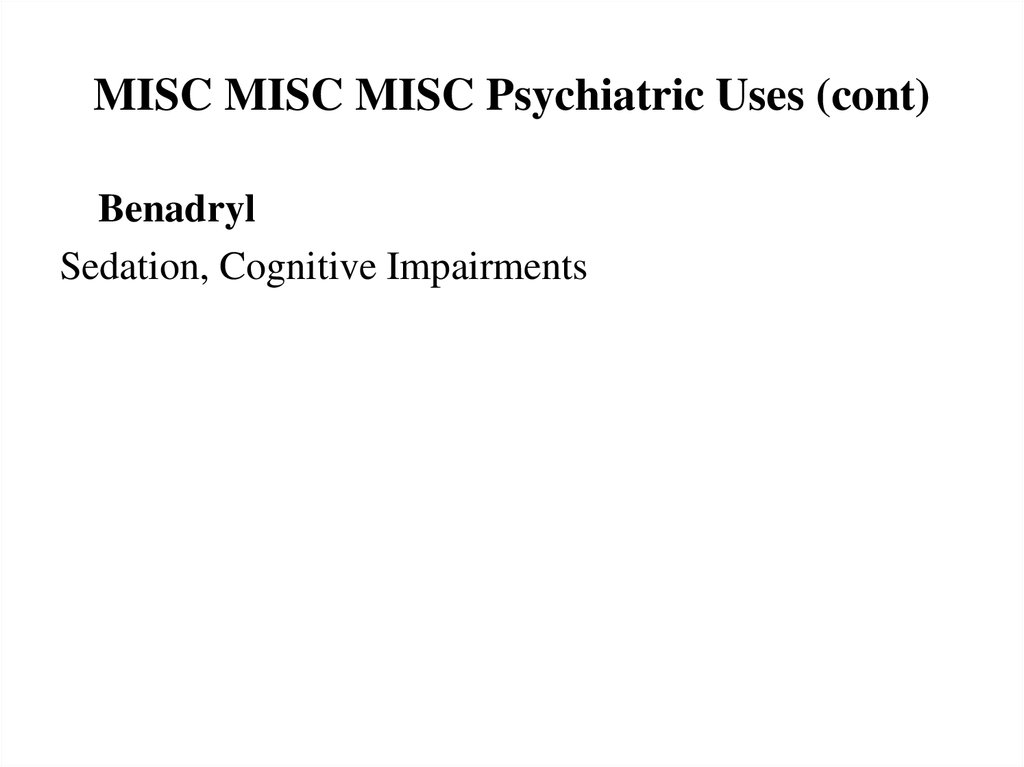



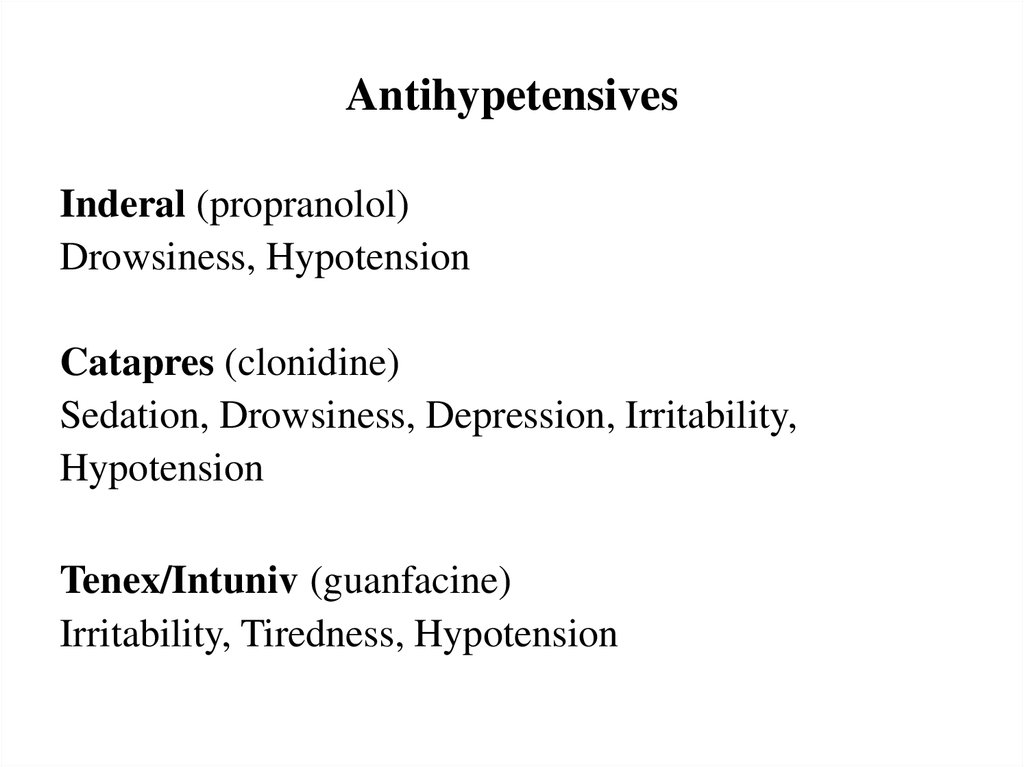

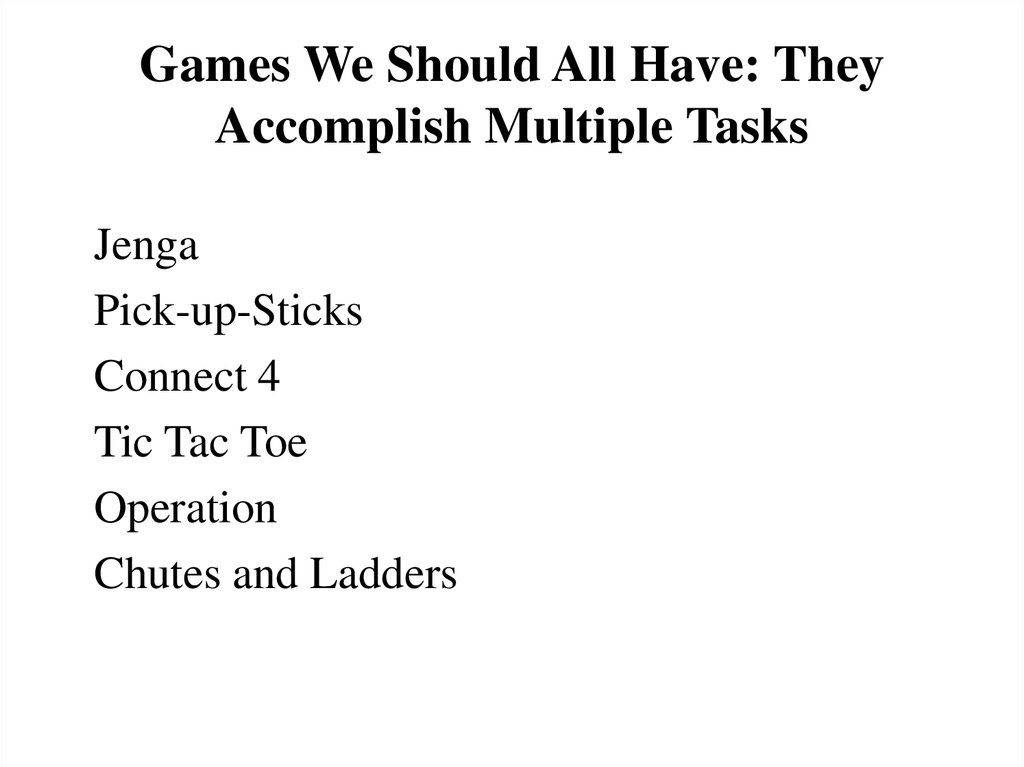
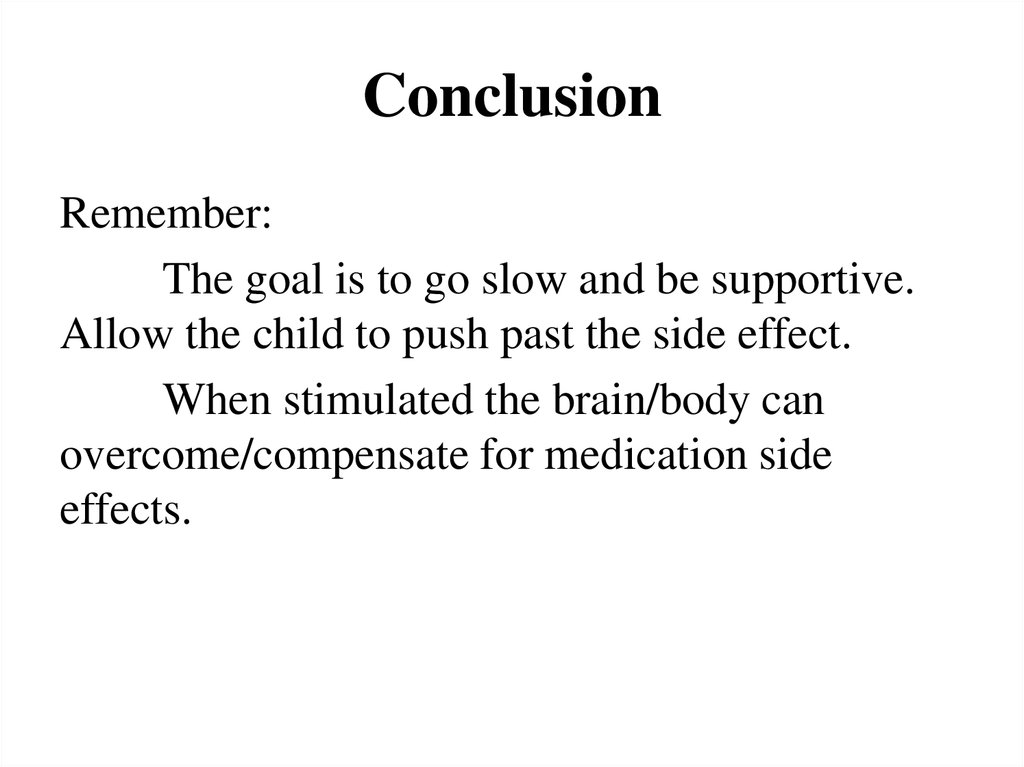

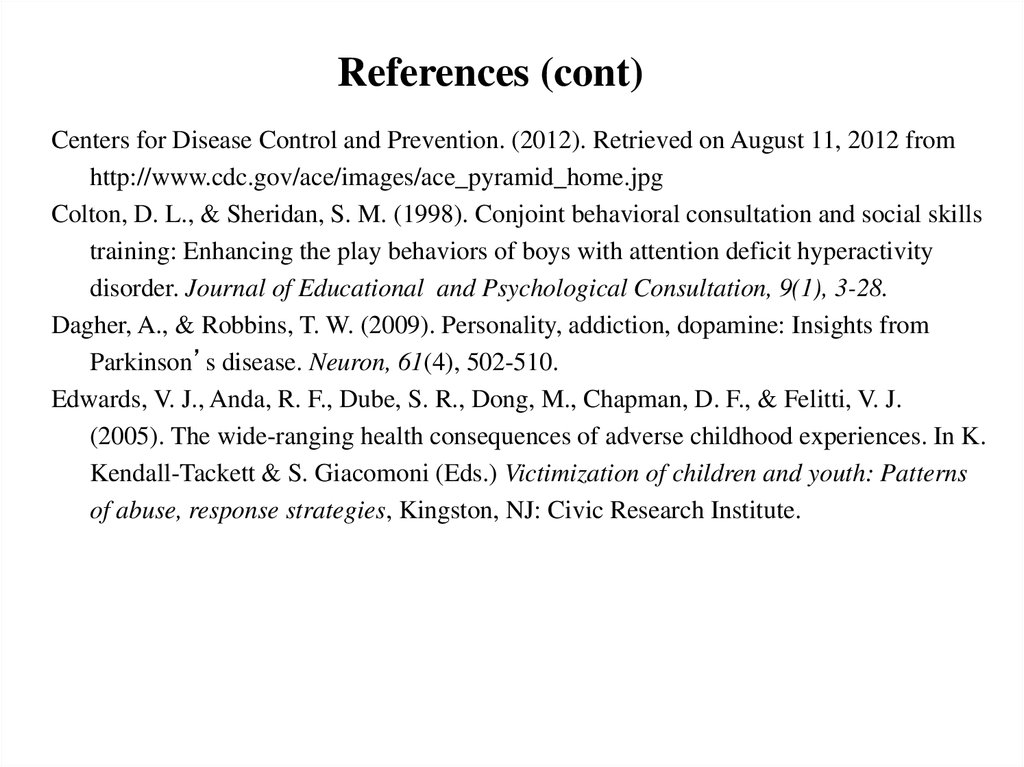



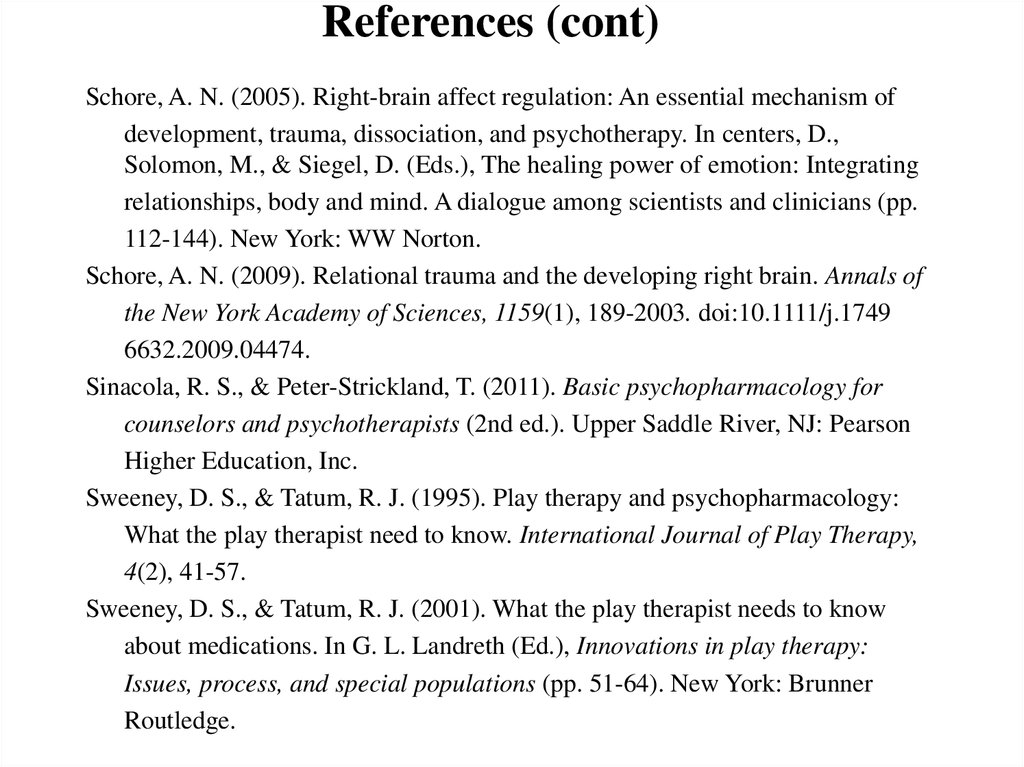

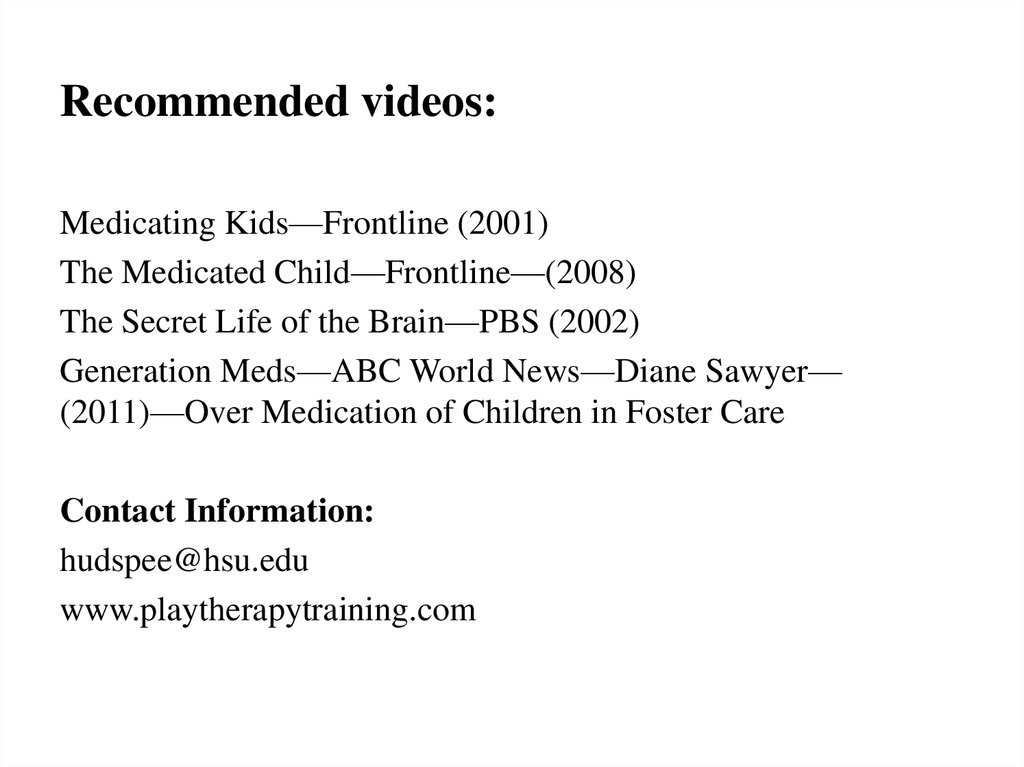
 Медицина
Медицина








